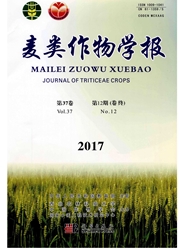

 中文摘要:
中文摘要:
为给我国小麦核心种质的合理利用提供参考依据,对我国262份小麦微核心种质进行了抗秆锈、条锈和白粉病鉴定。结果表明,我国小麦微核心种质对秆锈、条锈和白粉病的抗病频率不高,在262份微核心种质材料中,抗秆锈病的材料有40份,占全部材料的15.3%;抗条锈病的材料有59份,占全部材料的22.5%;抗白粉病的材料有20份,占全部材料的7.6%;其中,选育品种和国外引进品种对秆锈病的抗性较好,而对条锈和白粉病的抗性却较差,地方品种对条锈病的抗性较好;同时,发现部分材料分别兼抗两或三种病害,这些兼抗多种病害的材料是小麦抗病育种中很好的抗源亲本,有很大的应用价值。微核心种质材料中抗白粉病材料出现的频率较低,在抗病育种中急需发掘和引进新的抗源材料。
 英文摘要:
英文摘要:
In order to understand the resistance status in China wheat core germplasm,262 China wheat micro-core germplasm varieties had been identified for resistance to stem rust,stripe rust and powdery mildew.The results are as follows that 40 varieties were resistance to stem rust,accounting for15.3%,and 59 varieties were resistance to stripe rust,accounting for 22.5%,and 20 varieties were resistance to powdery mildew,accounting for 7.6%.The results indicated that the frequency of disease resistance to wheat stem rust,stripe rust and powdery mildew was very low in China wheat micro-core germplasm materials;Among them,the frequency of resistance to stem rust in breeding varieties and introduced varieties were higher comparing with wheat landraces,but they showed bad resistance to stripe rust and powdery mildew;Comparing with other two,the frequency of resistance to stripe rust in wheat landraces was better.It was very useful to find some varieties which showed resistance to two or three diseases and can be used in the breeding for resistance.All materials showed low resistance to powdery mildew,the urgent need to discover and innovate new resistance materials to meet current such bad conditions.
 同期刊论文项目
同期刊论文项目
 同项目期刊论文
同项目期刊论文
 期刊信息
期刊信息
